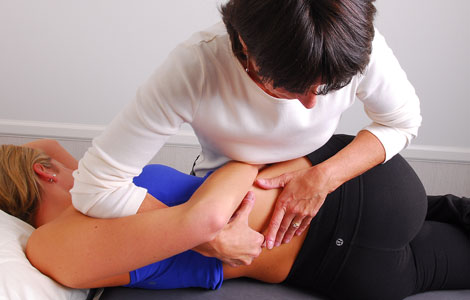Laurie's Blogs.
Nov 2017
Manual therapy research

Are you familiar with the following paper?
Krekoukias et al., Spinal mobilization vs conventional physiotherapy in the management of chronic low back pain due to spinal disk degeneration: a randomized controlled trial. J Man Manip Ther 25 (2017) 66-73.
https://www.ncbi.nlm.nih.gov/pubmed/28559665
This RCT compared the effectiveness of spinal mobilization/manual therapy (MT) vs. conventional physiotherapy (CP) vs. sham treatment (ST) in subjects with low back pain and associated spinal disc degeneration.
The 75-subject pool consisted of low back pain sufferers who were referred for physiotherapy after orthopaedic physician visit. Inclusion criteria included pain in the lumbar region for more than three months accompanied by MRI scan within 12 months. Exclusion criteria included: history of spinal surgery, autoimmune disease, spondylolysis/listhesis, fractures, pregnancy, cardio-respiratory pathology, stroke, CE syndrome, continuous use of pain medications, spinal inflammation, spinal tumor, subjects receiving immunosuppressant medication, corticosteroid medication use in the last month and osteoporosis.
These subjects were then allocated randomly to 3 groups to receive either MT, CP or ST. The MT group received once a weekly, 10-minute spinal mobilization to the levels of the spine shown with disc degeneration. The CP group received once a weekly, 5 minutes of static stretch to the lower limbs, 20 minutes of TENS in the lumbar area and 15 minutes of massage to the lower back region. The ST group received once a weekly, 10-minute gentle touch to the skin overlying the lumbar spine.
Based on measurements taken by numerical pain rating scale (NPRS) and two questionnaires (Oswesrtry and Roland-Morris) the trial showed significant differences between MT and ST group and between the MT and CP group. No significant difference was observed between the ST and CP group.
A 6-month follow up was conducted through asking the subject whether they sought for professional help regarding their low back pain. In the MT group, one sought further treatment, 10 in the CT group and 21 in the ST group. This trial was able to show positive results of manual therapy perhaps by their utilization of the comprehensive exclusion criteria.
Other than the part where they call conventional physiotherapy, “static stretches, TENS, and massage” (making me vomit a little bit in my mouth), I like this study. Mobilizations were best for the back pain. The other thing I want to point out is that this was treating spinal disc degeneration. My point in highlighting this study… GET your hands on those spines!
People can talk, and tell us that the spinal mobilizations helped. Dogs can’t, but it doesn’t mean that manual therapy won’t work on them. It just means that to NOT look at the human research when choosing treatments for the degenerative dog spine, you might not be being as effective as you could be (without using manual therapy)!
Mob the spine. Mic drop. Laurie out.


